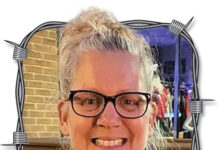Patience is a virtue — especially when it comes to handling livestock. I can’t remember the number of times in my life that my father chastised (a nice way of saying “cursed”) me for failing to exhibit any patience in dealing with animals.
I can remember, so many times, having a group of cattle right at the gate we were trying to put them through, when I would try to crowd them too much, resulting in them turning and running to the far side of the pasture. “If you would just have let them alone, the lead cow would have taken them right through!” I can still hear the echoes of his voice.
Today, as I head into my late fifties, I finally get it, and realize that my third-grade teacher was probably right when she said I might be a slow learner. It was one of those rare, warm, winter days when I had everything fed and checked by about 10 a.m. I needed to catch seven calves in five different pastures to take to the auction barn tomorrow. These were late-born calves that were too small to take with the big bunch last fall. I knew it was going to be tough to capture all of them, but I figured I had eight hours of sunlight left and with nothing else pressing and my wife out of the house, I’d make a relaxing day of it.
The first farm would be the most difficult since the corral is in the middle of 80 acres with no cross fences coming to it. I emptied a sack of range cubes around the inside perimeter as I called to the cows. Five minutes later, every one of the animals in the field were inside the pen, lapping up the cow candy, except for the two calves I wanted. I just got in my truck and sat for a few minutes.
As sure as my Dad had preached all those years ago, the calves gradually inched their way to the open gate. There they stood, each with a head and two feet inside the corral and both with a tail and two feet outside. In my younger days, I would have put the truck in gear and tried to scare them inside. But, today I sat.
A few minutes later, I calmly walked up and shut the gate after they moseyed on in. At the second farm, I used the range cubes and a ton of patience again. This was becoming too easy. The single heifer calf was the last one in, but she was in. Why didn’t I start using this method 40 years ago?
At the third farm, I unrolled a round bale down a lane leading to the pens. Twenty-five of the 30 cows went right for it, but some of the higher-headed females and, of course, the one calf, held their distance. I waited and waited, but none ever made the move toward the confined area. I had decided that if I could get all but this one, it would be a successful day, so I headed the truck to the outlet gate of the field.
As I stopped and locked the gate, I saw the calf head to the lane. A few minutes later I circled around through another gate and this calf, too, was caught. I was on a roll.
At the fourth farm, the calf was the first one in. I didn’t even have to sort. The last place had the largest herd of cattle. It’s 140 acres, but there is a small, three-acre paddock right at the entrance to the corral system. I unrolled another bale in the paddock and every cow came in with both the remaining calves. It took an hour of patience, constantly backing up, pulling forward, and driving around in circles (the neighbors and passers-by probably thought I had finally lost it) in the truck until the last two calves finally gave up.
I was really proud of myself for showing that much patience for an entire day, but I had been rewarded by capturing all the rest of last year’s calf crop. I was really looking forward to getting home, because my wife was supposed to have a grand dinner waiting for me at dark.
Where could she be? I am sooo hungry. That woman is never on time for anything. Dang it! I want that meal and I want it right now. The heck with patience — I’m starving.
Jerry Crownover is a farmer and former professor of Agriculture Education at Missouri State University. He is a native of Baxter County, Arkansas, and an author and professional speaker. To contact Jerry about his books, or to arrange speaking engagements, you may contact him by calling 1-866-532-1960 or visiting www.ozarksfn.com and clicking on 'Contact Us.'






